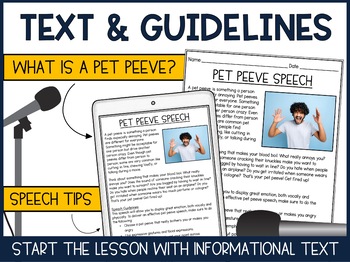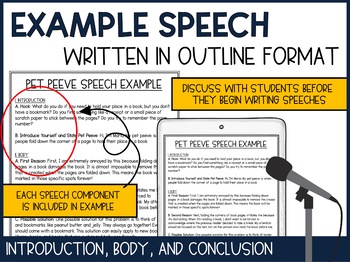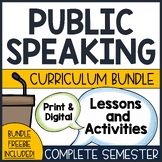Public Speaking Pet Peeve Speech | Lesson Plan | Print & Digital
- PDF
- Google Apps™

What educators are saying
Also included in
- Everything you need to teach public speaking! This printable and digital bundle is jam-packed with engaging lessons and activities your students will love! The comprehensive and easy to use lessons include directions, examples, rubrics, and more! Save time and build student confidence with this stepPrice $31.50Original Price $39.50Save $8.00
Description
Your students will love this fun speech! This printable and digital lesson plan has everything you need to teach students how to give a pet peeve speech, including an example speech and step-by-step writing template! Printable PDF and Google Drive versions are included.
INCLUDED WITH YOUR PURCHASE:
- Speech Description & Guidelines: The speech guidelines provide students with the meaning of a pet peeve and a brief overview of the speech requirements.
- “My Pet Peeve" Worksheet: This pre-writing activity requires students to identify their pet peeve, provide reasons to support their pet peeve choice, and provide a possible solution.
- Pet Peeve Outline Template: A template with the necessary speech components is provided for students to use as a guide when writing their speech in outline form.
- Pet Peeve Speech Example: An example speech, written in outline form, is provided to share with students before they begin the speech writing process.
- Speech Rubric: The rubric lists the necessary criteria for each major part of the speech. Review the rubric ahead of time to ensure students clearly understand the speech expectations.
Additional Public Speaking Resources:
Introduction to Speech Writing- Text, Outline, and Practice
Public Speaking Vocabulary- A Complete Unit
Public Speaking: Voice and Gestures- Practice, Text, and Activities!
Stage Fright Handout and Questions
200 Inspirational Quotes- Quote of the Day, Bell Ringers, Journal Prompts, etc.
Speech of Introduction- Practice speaking from notecards- Student Introductions
Public Speaking: Sales Speech- Students sell a product to the class!
Listening Skills- Graphic Organizer, Listening Survey, Activity, and Assessment
Storybook Speech- Oral interpretation of a children's book
Award Speech- Presenting and receiving an award
Want a FREE resource each month? Click HERE to follow Literacy in Focus, and you will be sent the monthly freebie!
Thank you!
©Literacy In Focus






